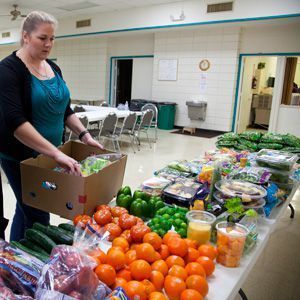
When I first met Heather[1] at the Native American clinic I was working at, she had been living with type 2 diabetes for over 15 years. She was well aware of the impact the disease can have. “My mom died from diabetes.” Heather lived in a rural Northern California community surrounded by majestic redwoods, meandering streams and characterized by high levels of poverty.
She was in my office for support on managing her blood sugars. “But what I really want is to get this weight off,” she lamented – Heather was also clinically obese. The high doses of daily insulin she took to control her diabetes actually contributed to her weight gain (which, paradoxically, made her blood sugars even harder to control).
After looking at the few blood sugar test results she brought in and discussing a new plan for her insulin management, we turned our attention to what she was eating and how healthy eating can help with blood sugar control (along with improving other health problems like hypertension, obesity, hyperlipidemia, and depression).
Heather quickly became emotional – “I know I should be eating healthier, but we can’t afford better food!” She spoke about eating a lot of instant noodles while trying to stretch her food budget and prepare healthier meals for her granddaughter. She also spoke about some of the foods she was receiving from a local food pantry which often consisted of breads, pastries and other highly refined and processed foods. These foods often have little nutritional value, and can be especially challenging for people living with diabetes to successfully meet their self-management goals.
“What can I do?” she asked, distraught and wiping away tears.
When healthy eating—the foundation for diabetes control—seems out of reach, we need to act.
Feeding America’s research demonstrates how profound this problem can be: each year over 46 million Americans access food through our network. More than half of the households we serve have a member living with high blood pressure, a third have a member with diabetes and 66 percent of households reported having to choose between paying for food or paying for medical care during the last year.
Making tradeoffs between food and medical care is fraught with health implications—especially for people living with chronic diseases like diabetes. Stretching medications, skipping doses and forgoing diabetes testing at home all make controlling one’s diabetes a challenge. Tradeoffs can increase the risk for both high blood sugars (which damage the body over time), and low blood sugars (which can cause acute medical emergencies). It is thus no surprise that food-insecure adults living with diabetes tend to have poorer diabetes control and are at high risk for diabetes complications like kidney disease, eye disease, and nerve damage.
What happens, then, when food banks work to systematically address the health-related needs of food insecure clients living with diabetes? The three-member food banks involved in Feeding America’s Diabetes Pilot project provided diabetes clients with healthy food boxes, diabetes education and referrals to primary care providers. Results from the pilot were overwhelmingly positive: clients with diabetes improved their blood sugar control, increased their consumption of healthy foods and had better medication adherence (suggesting a decrease in having to choose between food and medicine). Importantly, the pilot project also demonstrated that health interventions like this are feasible to conduct in food bank settings.
Today, we are building on lessons learned from the pilot project to better understand how food bank-based diabetes interventions can benefit the people we serve. The Feeding America Intervention Trial for Health – Diabetes Mellitus (FAITH-DM) is Feeding America’s first randomized controlled research trial and is being conducted at three member food bank sites. Starting in late 2015, the Alameda County Community Food Bank, Houston Food Bank and the Gleaners Community Food Bank of Southeastern Michigan began enrolling food pantry clients living with type 2 diabetes into the study.
FAITH-DM, which is being supported by the Laura and John Arnold Foundation, will allow us to more definitively identify how these food bank interventions can improve diabetes-related outcomes for the people we serve. In addition to building the evidence on what is effective, FAITH-DM will help Feeding America to inform our 200 member food banks on how to best implement diabetes interventions in community settings. The pioneering food banks involved in FAITH-DM are advancing our capacity as front-line responders to hunger and health disparities in America. We have an opportunity to positively impact both the people we serve and community health with this work.
But it is not easy work. Success in health promotion requires we develop partnerships with health organizations and other community-based agencies. We must improve our food acquisition and distribution processes to ensure that everyone in need of our services has access to enough nutritious foods for active, healthy lives. We must continue to research and implement effective programs that put people at the center of managing their health, equipped with the tools, knowledge, resources, and food to do so effectively.
Managing a chronic disease like diabetes requires multiple decisions each day on a range of complex processes. There are no vacations, no time-outs. At best, conditions like poverty and food insecurity only complicate diabetes self-management—at worst, they make effective self-management impossible. This simple fact is true for the millions of Americans who live with diabetes while facing food insecurity. People like Heather. Her question—“what can I do?”—is only part of the story.
The other part, of course, is “what can we do.”
*Morgan Smith is the manager of interventions for healthy at Feeding America.
[1] Name changed to protect anonymity.
